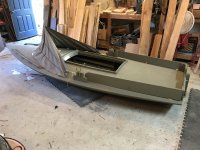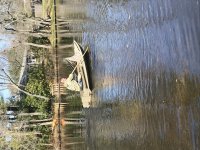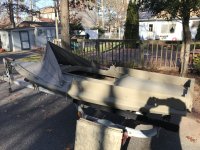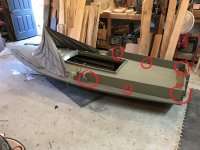You are using an out of date browser. It may not display this or other websites correctly.
You should upgrade or use an alternative browser.
You should upgrade or use an alternative browser.
Decoy rack? On sneak boat.
- Thread starter Dylan N
- Start date
Steve Sanford
Well-known member
Dylan~
I have made and restored several stool racks over the years. Materials have included plywood, White Pine, White Cedar and Mahogany (Philippine). You do not need - or want - the weight of Oak. And, plywood does not need to be marine for this application. A good AC plywood is perfectly acceptable - at much lower cost.
This traditional stool rack - on a Barnegat Bay Sneakbox built by VanSant - is 3/4-inch White Cedar:
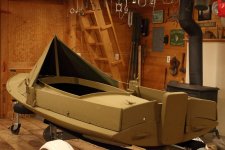
This rack is half-inch White Pine - high-quality clear stock. With all racks I like to fasten the hardware with machine screws and washers (usually brass) rather than screws - as the latter can easily pull out in use.
I believe my Dad designed (and built) this stool rack. It has 6 hinged sides and folds up like an accordion to stow beneath the rear deck whilst gunning.
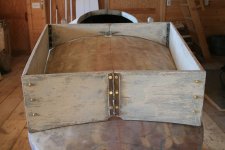
The sides on this one are 1/2-inch Mahogany and the forward piece is half-inch ply. I used no hardware. The forward ends slotted together and the aft end dropped over the pipe oarlock stanchions.
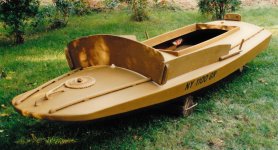
This old Hudson River duck skiff used a mix of 3/4-inch (sides) and half-inch (ends) clear White Pine.

In summary, I recommend half-inch AC plywood. I would sheath it with 6-ounce 'glass for durability. Use epoxy resin and seal any exposed end grain with 2 or even 3 applications of resin. Hardware should be brass or stainless steel. I prefer brass so I can easily grind off any protruding machine screw ends with a disc sander.
On the other hand.... I generally do not put stool racks on my gunning boats. I keep my decoys in compartmented (slotted) bags and stow them either on deck (lashed) or in the cockpit when getting to and from my gunning spot.
Hope this helps!
SJS
I have made and restored several stool racks over the years. Materials have included plywood, White Pine, White Cedar and Mahogany (Philippine). You do not need - or want - the weight of Oak. And, plywood does not need to be marine for this application. A good AC plywood is perfectly acceptable - at much lower cost.
This traditional stool rack - on a Barnegat Bay Sneakbox built by VanSant - is 3/4-inch White Cedar:

This rack is half-inch White Pine - high-quality clear stock. With all racks I like to fasten the hardware with machine screws and washers (usually brass) rather than screws - as the latter can easily pull out in use.
I believe my Dad designed (and built) this stool rack. It has 6 hinged sides and folds up like an accordion to stow beneath the rear deck whilst gunning.

The sides on this one are 1/2-inch Mahogany and the forward piece is half-inch ply. I used no hardware. The forward ends slotted together and the aft end dropped over the pipe oarlock stanchions.

This old Hudson River duck skiff used a mix of 3/4-inch (sides) and half-inch (ends) clear White Pine.

In summary, I recommend half-inch AC plywood. I would sheath it with 6-ounce 'glass for durability. Use epoxy resin and seal any exposed end grain with 2 or even 3 applications of resin. Hardware should be brass or stainless steel. I prefer brass so I can easily grind off any protruding machine screw ends with a disc sander.
On the other hand.... I generally do not put stool racks on my gunning boats. I keep my decoys in compartmented (slotted) bags and stow them either on deck (lashed) or in the cockpit when getting to and from my gunning spot.
Hope this helps!
SJS
Dylan N
New member
Big help Steve. Thank you. Great photos and description. This will definitely help me.Dylan~
I have made and restored several stool racks over the years. Materials have included plywood, White Pine, White Cedar and Mahogany (Philippine). You do not need - or want - the weight of Oak. And, plywood does not need to be marine for this application. A good AC plywood is perfectly acceptable - at much lower cost.
This traditional stool rack - on a Barnegat Bay Sneakbox built by VanSant - is 3/4-inch White Cedar:
View attachment 57519
This rack is half-inch White Pine - high-quality clear stock. With all racks I like to fasten the hardware with machine screws and washers (usually brass) rather than screws - as the latter can easily pull out in use.
I believe my Dad designed (and built) this stool rack. It has 6 hinged sides and folds up like an accordion to stow beneath the rear deck whilst gunning.
View attachment 57520
The sides on this one are 1/2-inch Mahogany and the forward piece is half-inch ply. I used no hardware. The forward ends slotted together and the aft end dropped over the pipe oarlock stanchions.
View attachment 57521
This old Hudson River duck skiff used a mix of 3/4-inch (sides) and half-inch (ends) clear White Pine.
View attachment 57522
In summary, I recommend half-inch AC plywood. I would sheath it with 6-ounce 'glass for durability. Use epoxy resin and seal any exposed end grain with 2 or even 3 applications of resin. Hardware should be brass or stainless steel. I prefer brass so I can easily grind off any protruding machine screw ends with a disc sander.
On the other hand.... I generally do not put stool racks on my gunning boats. I keep my decoys in compartmented (slotted) bags and stow them either on deck (lashed) or in the cockpit when getting to and from my gunning spot.
Hope this helps!
SJS
Bob Reitmeyer
Active member
Hi Dylan - Steve gave you great information. I've always called these racks "duck boards" and I like to have them so if nothing else you don't have things rolling off the deck and overboard - they should be removeable. I've also modified mine a bit so I can attach marsh grass. The combination of oarlocks (placement), side duckboards, rear duckboard and motor board are kind of a puzzle you will have to fit together. I would start with the placement and composition of the oarlocks which will give you the length for the side boards. The rear duckboard should connect to the transom - I just use 1x1 cedar lengths to slot into the handles on the transom. The rear duckboard will also need to be shaped so that when in place it doesn't interfere with the movement of the motor. Hopefully these pictures fill in the gaps of my explanation.
Attachments
Bob
The style on your BBSB are "sprung" in order to stay put. Correct? I don't think I've ever heard this discussed, but I imagine there is some trial and error or some method to get the components in the correct place so that spring tension keeps them intact when travelling.
The style on your BBSB are "sprung" in order to stay put. Correct? I don't think I've ever heard this discussed, but I imagine there is some trial and error or some method to get the components in the correct place so that spring tension keeps them intact when travelling.
Dylan N
New member
Bob thanks for pictures and more info. What are your racks made of cedar? Steve had good detail in material as well. The transom mount on this boat is weird and I’ve seen them just like mine on the same boats as mine. So I’m also trying to figure out so I just remove the metal plate and attach my 8hp yammer to an adjustable kicker or do something like u got a big slab of wood with 4 bolts.
Bob Reitmeyer
Active member
Hi Eric, personally I stow the boards inside the sneakbox for transport to the ramp. There definitely is a bit of thought needed plus some trial and error to get sufficient tension. I revised the one photo to outline the various connection points. What I was taught was to use two eye hooks for each connection of the sides to the rear. If you zoom in you'll see the extra pieces of wood to lock in the corners, at the oarlock and the "anchor" -not sure what its called- in the middle of the side duckboard to add tension.Bob
The style on your BBSB are "sprung" in order to stay put. Correct? I don't think I've ever heard this discussed, but I imagine there is some trial and error or some method to get the components in the correct place so that spring tension keeps them intact when travelling.
Attachments
Bob Reitmeyer
Active member
Mine are cedar - just painted with same paint as sneakbox. I may have sealed them, but I don't remember. White cedar is rot resistant so long as it doesn't stay wet for an extended time. My motor board is treated lumber with multiple coats of resin and attached with 4 bolts. The key is for the motor board to be tall enough that your propeller is at the correct depth. Hopefully someone here can better explain the sizing of the motor board. Or search previous posts. This site has a huge wealth of information! Good luck with your build!Bob thanks for pictures and more info. What are your racks made of cedar? Steve had good detail in material as well. The transom mount on this boat is weird and I’ve seen them just like mine on the same boats as mine. So I’m also trying to figure out so I just remove the metal plate and attach my 8hp yammer to an adjustable kicker or do something like u got a big slab of wood with 4 bolts.
Dylan N
New member
I understand the motor height and the keel relation I figured an adjustable kicker mount would help get skinny. Jim bucko I think has one on his. I’d like to find a piece of thick like delrin or nylon material then u know it will never go back as a motor mount.Mine are cedar - just painted with same paint as sneakbox. I may have sealed them, but I don't remember. White cedar is rot resistant so long as it doesn't stay wet for an extended time. My motor board is treated lumber with multiple coats of resin and attached with 4 bolts. The key is for the motor board to be tall enough that your propeller is at the correct depth. Hopefully someone here can better explain the sizing of the motor board. Or search previous posts. This site has a huge wealth of information! Good luck with your build!
Steve Sanford
Well-known member
Dylan~Steve what holds them racks to the boat?
The traditional Sneakbox in the first photo uses a combination of:
~ the forward ends key into the folding oarlock stanchions
~ 2 wooden "horns" about midway on the sides which poke through
~ hooks-and-eyes on the inside aft corners
~ the stern pieces are also held by a single "cleat" on the starboard side of the motor mount that sits in a metal socket fastened to the transom
The other stool racks rely primarily on gravity. The 2 "accordion-style" racks have 4 chocks - one on each inside corner - to keep them from sliding around.
BTW: I was just reminded today of another stool rack I have seen. It has slats on the bottom so it could be lifted off with the decoys in it - so the rig could be stored out of the weather. This was a chore done by a strong guide or two in a high-end hunting club.
All the best,
SJS


